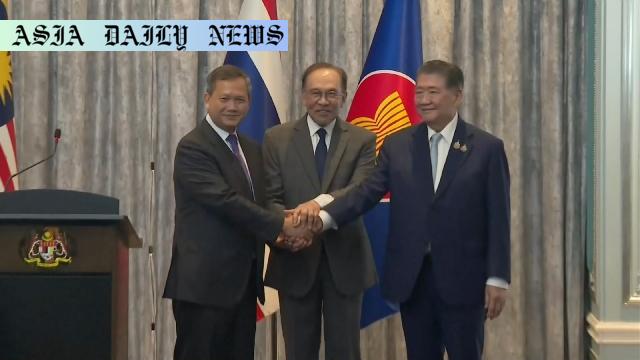Trade Agreements, Thailand and Cambodia celebrate new lower tariffs, fostering economic growth and partnerships with the US.
- Positive trade agreements lower US tariffs for Thailand and Cambodia to 19%.
- Leaders in both nations have celebrated the decision as promising for their economies.
- Thailand and Cambodia have agreed to an immediate ceasefire following border clashes.
- Thailand’s plan to import US pork and beef raises concerns among local farmers.

Introduction: New Trade Agreements Signal Progress
The United States has recently adjusted tariffs on goods imported from Thailand and Cambodia, reducing the initial proposal of 36% to a more favorable 19%. This decision has been enthusiastically received by both nations’ leaders as it signifies a positive shift in trade relations. Cambodian Prime Minister Hun Manet described the news as a significant boost for Cambodia’s economy, while Thai Finance Minister Pichai Chunhavajira emphasized the strong partnership between Bangkok and Washington. The new tariffs come as both countries take steps to resolve lingering tensions over a disputed border region, highlighting the interconnectedness of diplomacy and trade.
Economic Benefits of Lower Tariffs
The sharp reduction in tariffs comes as a bright spot for manufacturers and exporters in both Cambodia and Thailand. A 19% tariff allows greater affordability and competitiveness for goods entering the US market, opening up opportunities for both nations to increase exports. Cambodia, which is heavily reliant on textile and agricultural industries, stands to benefit significantly. Similarly, Thailand, with its diverse range of exports, including electronics, automotive parts, and seafood, is poised to leverage this favorable tariff rate to its advantage. Economic analysts predict that the reduced tariffs could invigorate job creation, increase GDP contributions from exports, and deepen trade ties between the US and Southeast Asia.
Diplomatic Strides Pave the Way
Reduced tariffs are not the only significant development; they coincide with the resolution of a border-related conflict between Thailand and Cambodia. In July, the two nations were engaged in a fierce dispute over a contested region, with tensions threatening to escalate into prolonged hostilities. The introduction of trade agreements served as leverage for the United States, encouraging both countries to agree to an immediate ceasefire. This diplomatic intervention not only secured stability in the region but also underscored the role of economic cooperation in fostering peace and diplomacy. As both countries shift their focus toward economic growth, the ability to collaborate and rebuild trust at the governmental level has been noticeably amplified.
Mixed Reactions to US Pork and Beef Imports
Amid the fanfare surrounding the new trade deals, concerns have surfaced within Thailand’s agricultural sector over the potential impact of US pork and beef imports. While these imports are intended to solidify trade partnerships with Washington, local farmers fear that the highly efficient and industrialized US meat industry could severely disrupt domestic markets. Thailand’s pork industry, which relies heavily on small, family-operated farms, could face immense pressure as cheaper US products drive down market prices. Local farmers like Worawut Siripun have vocally expressed fears of oversupply, price crashes, and economic instability affecting both livestock growers and ancillary businesses, such as animal feed producers. The Thai government, aware of these concerns, is adopting a cautious approach to balance import policies that protect domestic farming communities while fulfilling its trade commitments with the US.
The Path Forward for Regional Collaboration
This trade deal, while focused on US-Southeast Asia relations, also carries implications for regional partnerships. Thailand and Cambodia have showcased their ability to set aside disputes and cooperate in shared economic interests. This united front could pave the way for deeper integration between ASEAN nations and external trading powerhouses. The new tariffs set a precedent for how diplomacy, peacebuilding, and trade negotiations can coexist to address critical regional and global challenges. As the trade landscape evolves, stakeholders in Thailand and Cambodia will need to remain engaged and agile to capitalize on emerging opportunities and mitigate potential risks to local industries.



Commentary
Historical Significance of the Tariff Reduction
The recent trade deals between the US, Thailand, and Cambodia mark a significant pivot in international economic relations. By reducing tariffs from an initially aggressive 36% to a more moderate 19%, the United States has demonstrated its willingness to foster partnerships in Southeast Asia. Historically, such reductions are not just economic tools but also serve as diplomatic bridges, especially in regions prone to regional disputes like the Thailand-Cambodia border tensions. This approach highlights the intersection of economic policy and international diplomacy, emphasizing the role of trade as a catalyst for peace.
Challenges Facing Local Economies
Despite the optimism surrounding these deals, they bring to light challenges for domestic stakeholders, particularly within Thailand’s agricultural ecosystem. The possibility of increased US pork and beef imports introduces an external competitive force into a market largely sustained by smaller, family-run operations. For these producers, the threat is existential. Their livelihoods could be jeopardized by imported products that are produced at a scale and efficiency difficult for local farmers to match. Balancing these imports while ensuring protections for domestic industries will test Thailand’s economic policymakers in the months and years to come.
The Way Forward
In the long run, the success of these trade agreements will depend not only on their ability to open markets but also on ensuring sustainability and equity across participating nations. Thailand and Cambodia have an opportunity to channel revenue from increased exports into strengthening their economies while reinvesting in sectors under pressure from these agreements. Simultaneously, initiatives that combine diplomacy, peacebuilding, and trade—much like the agreement brokered by the US—should become templates for resolving sticky geopolitical challenges. As we watch this story unfold, the hope is that the deal not only boosts trade but also secures long-term growth and stability for all parties involved.